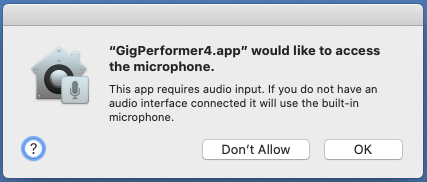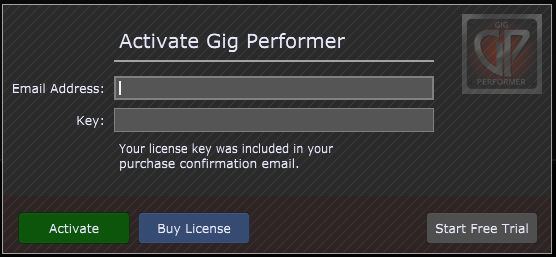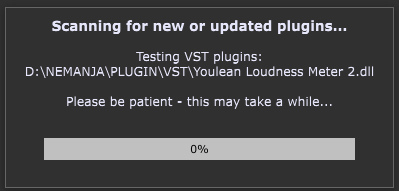Before launching Gig Performer, make sure that all audio and MIDI interfaces connected to your system are powered on. If no external audio interface is connected, Gig Performer will try to use your computer's built-in input and output if available. If you have more than one interface connected, you'll be able to choose among them after the application launches. Note that you can use different interfaces for input and output if desired (refer to the Audio I/O section for more information).
Note: if you are running Gig Performer on Mac OS X 10.14 or above, you will be prompted to allow access to the "microphone":

You must allow this otherwise Gig Performer will be unable to receive the audio from your guitar, microphone or other audio device that you plug into any of the inputs of your audio interface.
When Gig Performer is first launched, the following dialog will appear:

If you have purchased a license, enter your email address, and type in or paste the activation key (your key is emailed to you when you buy a license; make sure your anti-spam blocker didn't prevent the confirmation email with your license key from being received). Then click on the Activate button to activate your copy of Gig Performer 4.
Note: you need an Internet connection to activate Gig Performer.
If you have not yet purchased a license, click on the Start Free Trial button to access a fully operational trial version of Gig Performer for a period of 14 days (the dialog will also show you how many days you have remaining for this trial).
You can purchase a license key at any time by clicking on the Buy License button.
Note: when Gig Performer is in trial mode:
- there will be random momentary dropouts in the audio,
- the screen will flash red,
- All relevant options in the Auto Sampler Generator are locked and cannot be changed.
Before using Gig Performer, please make sure you agree to the license agreement, a copy of which is included (see Appendix -> License agreement).
Immediately after launching, Gig Performer will scan your system looking for plugins and the following dialog will appear:

When running Gig Performer on macOS systems, it will scan for VST, VST3 (Virtual Studio Technology) and AU (Audio Unit) plugins; when running on Windows systems, it will look for all VST and VST3 plugins. Note that only 64-bit plugins are supported.
Note: If you are a Windows user, you may have to tell Gig Performer what folders to search, since there is no single location where all plugins are guaranteed to be installed.
To do so, launch Gig Performer, go to the Windows menu, then select Plugin Manager. In the resultant window, click on Manage, then choose the Set VST folders for scanning option. We suggest that you begin by having Gig Performer search in the folder C:\Program Files\VstPlugins. If you have additional plugins stored in other folder locations (as some plugin and DAW manufacturers automatically create), the Plugin Manager allows you to easily add other folders to scan.
This scanning process can take some time the first time you use Gig Performer but will be nearly instantaneous on subsequent launches unless you have installed or updated any plugins since the last usage (if you like, you can disable the automatic scan completely in the General options dialog).
Note: Gig Performer 4 comes with a number of specialized plugins to handle basic MIDI and audio operations. Some third-party plugin vendors have kindly provided us with versions of some of their commercial plugins which are used in some of our templates to make it easier for new users to work with Gig Performer if they do not have their own plugins yet.
Further reading:
- FAQ page
- Top websites for free audio plugins and how to use them in Gig Performer
- Basic terminology in Gig Performer